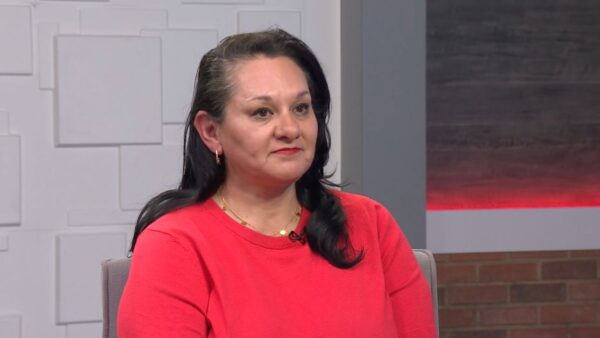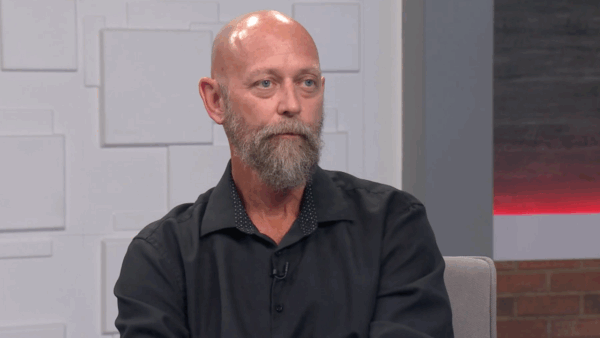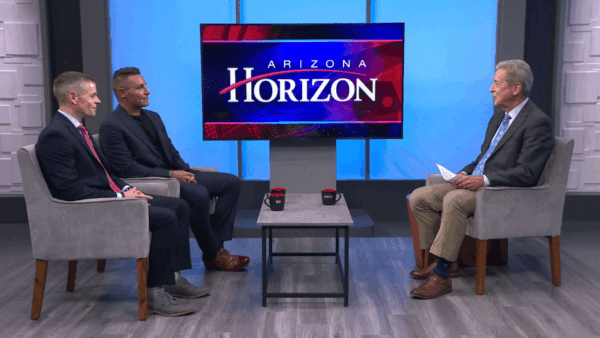Bison didn’t arrive at the north rim of the Grand Canyon until the early 2000s, but now they are taking over the area and the ecosystem can’t keep up.
The bison were originally brought to other parts of Arizona about one hundred years ago to cross-breed with cattle. The experiment failed, and the large animals settles in the Kaibab Plateau where there’s plenty of food, few predators and they are protected by the law that prevents open hunting.
“Starting at about the 1990s or so there were maybe 100 bison on the north rim of the Grand Canyon,” says Emily Davis, a spokeswoman for the park. “Now that number has increased over the years… What we’re really trying to do right now is reduce the herd over the next three to five years.”
Wildlife Biologist at the Grand Canyon Brandon Holton says the ecosystem hasn’t evolved with the number of bison which is why some negative impacts are being seen. Eating 30 pounds of grass a day per bison, the animals have overgrazed the land.
“I think they need to be controlled, and they need to be rounded up and moved out of the park,” Grand Canyon Program Coordinator for the Sierra Club Alicyn Gitlin says. “I think the protection of park resources should be the ultimate goal of this project. I think it’s really important that we act now to move these animals away from the park.”
The goal is to move the bison to an area that is more fit to deal with their species. Not only are the bison putting strain on the grass, but they’re also taking food away from other animals like mule deer and elk.
This story is part of Elemental: Covering Sustainability, a multimedia collaboration between Cronkite News, Arizona PBS, KJZZ, KPCC, Rocky Mountain PBS and PBS SoCal.
TED: A BISON IS PART OF THE GRAND CANYON LOGO, BUT BISON DIDN'T START ARRIVING IN GREAT NUMBERS AT THE NORTH RIM OF THE GRAND CANYON UNTIL THE EARLY 2000S. BISON WERE ORIGINALLY BROUGHT TO OTHER PARTS OF ARIZONA A HUNDRED YEARS EARLIER IN AN EFFORT TO CROSS-BREED THEM WITH CATTLE. THAT EXPERIMENT MAY HAVE FAILED, BUT AS PRODUCER ALYSSA ADAMS AND PHOTOGRAPHER ROB MCJANET HAVE FOUND THE ANIMALS ARE NOW THRIVING IN AN ENVIRONMENT THAT CAN’T SUSTAINT THEM.
REPORTER: WHEN A 2,000-POUND ANIMAL STANDS BETWEEN YOU AND YOUR DESTINATION, THE LAWS OF PHYSICS DEMAND YOU GIVE WAY. ON A BUSY ROAD THROUGHT THE NORTH RIM OF THE GRAND CANYON, THE BISON ARE OUT. GIVING TOURISTS SOME DIGITAL MEMORIES AND MAKING THE TRIP HOME A LITTLE SLOWER.
EMILY: THE BISON HERD THAT IS APART OF THE GRAND CANYON NOW IS DESCENDED FROM A HERD THAT WAS BROUGHT INTO THE HOUSE ROCK AREA IN 1906.
REPORTER: A COMBINATION OF DROUGHT, FOREST FIRE AND HUNTING ALL PUSHED THE HERD UP TO THE KIBAB PLATEAU, WHERE THEY FOUND LOTS OF FOOD, FEW PREDATORS AND PROTECTION OF SORTS FROM THE NATIONAL PARK SERVICE, WHERE OPEN HUNTING IS NOT ALLOWED.
EMILY: SO IN THE 1990S OR SO, THERE WERE MAYBE A HUNDRED BISON ON THE NORTH RIM OF GRAND CANYON NATIONAL PARK, AND THAT NUMBER HAS INCREASED OVER THE YEARS.
REPORTER: IT HAS BECOME INCREASINGLY COMMON AS THE HERD GROWS TO AN ESTIMATED 600 BISON TODAY, ALL MAKING THEIR MARK ON A WILDERNESS THAT ECOLOGICALLY ISN'T MADE FOR THESE NUMBERS.
BRANDON: BY ALL INDICATION, AT LEAST IN OUR MORE MODERN TIMES, YOU KNOW, BISON WERE NOT HERE ESSENTIALLY, AT LEAST IN THE NUMBERS THAT THEY ARE OUT HERE NOW, AND SO THE ECOSYSTEM JUST HASN'T EVOLVED WITH THAT NUMBER OF BISON ON THE LANDSCAPE AND THAT'S WHY YOU ARE STARTING TO SEE ALL OF THESE ADVERSE IMPACTS.
REPORTER: YOU SEE WHEN YOU WEIGH NEAR FROM 1700 TO 2500 POUNDS IT TAKES A LOT OF FOOD TO FUEL YOU. UP TO 30 POUNDS OF GRASS A DAY PER BISON.
BRANDON: YOU WILL GRASSES UPWARDS OF THIS HIGH, MAYBE EVEN A LITTLE HIGHER DEPENDING ON TIME OF YEAR, BUT OUT HERE YOU JUST HAVE -- OUR MEADOWS ARE JUST OVER GRAZED.
REPORTER: FEWER GRASSES MEAN LESS FOOD FOR OTHER CRITTERS LIKE MULE DEER AND ELK. AND THESE BIG ANIMARLS DON’T TREAD LIGHTLY. WE HIKED SOME FOREST OF THE CANYON TO AN OLD SPRING THAT IS A FAVORITE OF THE BISON.
BRANDON: THE BISON REALLY FOUND THIS ROUGHLY FIVE YEARS AGO.
REPOTER: IN A PLACE WHERE WATER RESOURCES ARE SCARCE, THIS ANIMAL CAN TURN A SPRING INTO A MUD HOLE.
BRANDON: IT HAS A HUGE IMPACT ON A LOT OF SPECIES THAT RELY ON THIS WATER SOURCE FROM MULE DEER TO CARNIVORE SPECIES TO OUR 22 DIFFERENT BAT SPECIES HAVE HERE IN THE CANYON.
REPORTER: THERE IS LITTLE DEBATE THAT THESE GIANT ANIMALS NEED TO FIND A BETTER PLACE TO ROAM. MANY CONSERVATIONISTS LIKE ALISSON GITLAN FROM THE SIERRA CLUB AGREE.
ALLISON: I THINK THEY NEED TO BE CONTROLLED, AND THEY NEED TO BE ROUNDED UP AND MOVED OUT OF THE PARK. I THINK THE PROTECTION OF PARK RESOURCES SHOULD BE THE ULTIMATE GOAL OF THIS PROJECT, AND I THINK IT'S REALLY IMPORTANT THAT WE ACT NOW TO MOVE THESE ANIMALS AWAY FROM THE PARK.
REPORTER: ACT NOW, BECAUSE AS THE HERD WANDERS THE KIBAB WITH NATURAL PREDITORS THAT KEEP THEIR REPRODUCTION IN CHECK, THEY COULD NUMBER AS HIGH AS 1500 IN TEN YEARS. SO BIOLOGISTS, CONSERVATIONISTS AND THE NATIONAL PARK SERVICE WRESTLE WITH THE REALITY THAT TO PROTECT ONE RESOURCE, THEY MAY HAVE TO HARM ANOTHER.
EMILY: WE'RE TRYING TO REDUCE THE HERD AS QUICKLY AS WE CAN OVER THE NEXT THREE TO FIVE YEARS.
REPORTER: THE SHORT TERM PLAN IS TWO PRONGED. SOME OF THE HERD WILL BE ROUNDED UP AND MOVED TO AN AREA THAT CAN HANDLE THEM, ECOLOGICALLY SPEAKING. AN IDEA SAVORED BY THE SIERRA CLUB.
ALLISON: I THINK WE WOULD ALL LIKE TO SEE THAT NON-LETHAL CULLING BE THE FIRST GOAL AND THE PRIMARY GOAL.
REPORTER: BUT THESE BIG GUYS CAN BE SURPRISINGLY ELUSIVE. BUT WE HEARD THEM IN THE FOREST A NUMBER OF TIMES, BUT SPOOKED THEM BEFORE WE EVER SAW THEM.
BRANDON: IT'S NEARLY IMPOSSIBLE TO GET THEM TO MOVE WHERE YOU WANT THEM TO GO.
REPORTER: STILL AN EXPERIMENTAL EFFORT A FEW YEARS AGO HAD SOME SUCCESS.
BRANDON: WE WERE ABLE TO CORRAL ROUGHLY 50 ANIMALS. AND WE ACTUALLY MOVED 19 DOWN TO HOUSE ROCK VALLEY.
REPORTER: THOSE KINDS OF NUMBERS WON'T MAKE MUCH OF A DENT IN NEED AT IT FUTURE, SO THE SECOND PART OF THE PLAN IS LETHAL CULLING, WHERE VOLUNTEER HUNTERS WILL WORK WITH THE PARK SERVICE TO SHOOT BISON AND THE MEAT WILL BE DONATED TO TRIBES AND FOOD BANKS.
BRANDON: MOST LIKELY IT WILL LOOK SIMILAR TO SOME OF THE OTHER PARKS HAVE DONE WITH ELK, WHERE WE EMPLOY SKILLED VOLUNTEERS TO ACTUALLY GO OUT AND HELP US REDUCE THE HERD.
REPORTER: THE GOAL IS THAT A HERD OF JUST 200 WILL BE LEFT TO ROAM THE CANYONS AND FORESTS INSIDE THE PARK. MAJESTIC IS A TERM USED OFTEN WITH THIS VIEW AND THIS ONE. THE HOPE IS THAT THE MAJESTY OF BOTH CAN BE PRESERVED TOGETHER.
BRANDON: THEY ARE JUST BEING BISON. YOU CAN'T BLAME THEM. THEY ARE FANTASTIC, INCREDIBLE CREATURES, BUT THEY JUST NEED TO BE IN THE RIGHT PLACE, IN THE RIGHT NUMBERS.
Emily Davis: Spokeswoman, Grand Canyon National Park
Brandon Holton: Wildlife Biologist, Grand Canyon National Park
Alicyn Gitlin: Grand Canyon Program Coordinator, Sierra Club























